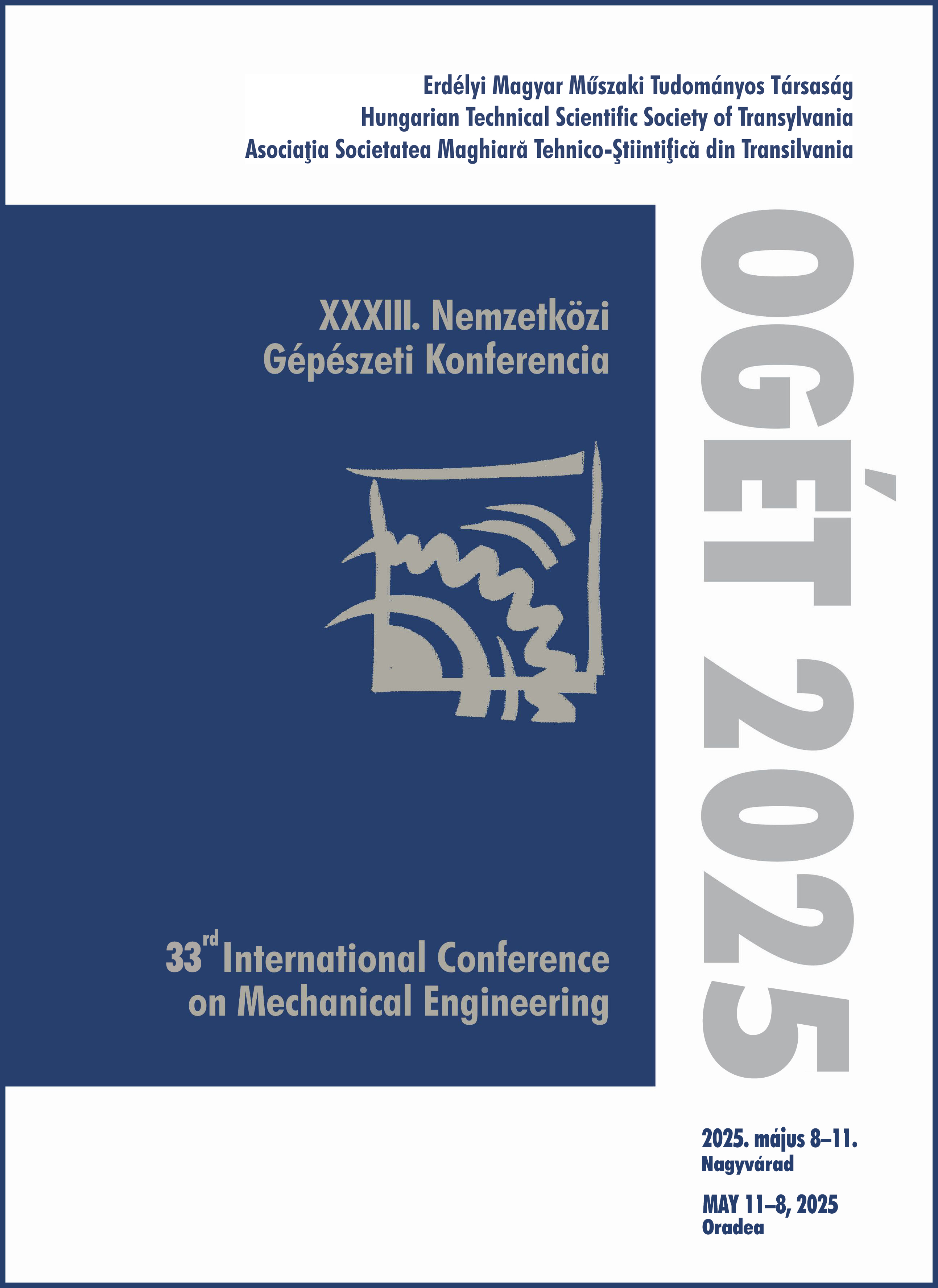Gépi tanulás alkalmazása a trochoidális marási szerszámpálya optimalizálásban
Application of machine learning in trochoidal milling tool path optimization
Keywords:
trochoidal milling, Bézier curve, artificial neural network, tool path planning, optimization, /, trochoidális marás, Bézier görbe, mesterséges neurális hálózat, szerszámpályatervezés, optimalizálásAbstract
Slot machining is considered a challenging manufacturing task. Due to the closed allowance material, it is difficult to ensure ideal machining conditions. The trochoidal milling strategy can provide a well-controlled radial depth of cut, making it a favourable solution for machining hard-to-access areas. Spline-based methods of tool path optimization were found to be superior among the possible strategies. However, these algorithms come with great computational costs; therefore, their industrial applications are not yet widespread. The aim of this study is to develop a machine learning based tool path optimization method, reducing the path generation time while sustaining the machining efficiency.
Kivonat
A trochoidális marási stratégia alkalmazása hatékony megoldást nyújt a körülzárt alakzatok megmunkálására, mivel a hurkolt szerszámpályák elősegítik az ideális megmunkálási körülmények biztosítását, többek közt a szerszám radiális bemerülésének szabályozhatóságával. A pályaszakaszok meghatározására használt stratégiák közül a spline görbe alapú módszerek kiemelkednek a hatékonyságot tekintve, azonban az optimális szerszámpályák létrehozásának számításigénye jelentős, így ezek a módszerek az ipari alkalmazásokban egyelőre nem terjedtek el. A kutatás célja egy gépi tanulás alapú pályatervezési módszer fejlesztése, amely segítségével csökkenthető a pályagenerálási idő a megmunkálás hatékonyságának megőrzése mellett.
References
István Szalóki, Sándor Csuka, and Sándor Sipos, ‘New Test Results in Cycloid-Forming Trochoidal Milling’, Acta Polytechnica Hung, vol. 11, no. 2, 2014.
Ashutosh Khatri, Muhammd P. Jahan, and Jianfeng Ma, ‘Assessment of tool wear and microstructural alteration of the cutting tools in conventional and sustainable slot milling of Ti-6Al-4V alloy’, vol. 105, pp. 2799–2814, 2019.
A. K. O. Gnytko, ‘Theoretical research of the chip removal process in milling of the closed profile slots’, Arch. Mater. Sci. Eng., vol. 113, no. 2, pp. 69–76, Feb. 2022, doi: 10.5604/01.3001.0015.7019.
G. Gómez et al., ‘Comparison between milling roughing operations in full slotting manufacturing: trochoidal, plunge and conventional milling’, IOP Conf. Ser. Mater. Sci. Eng., vol. 1193, no. 1, p. 012003, Oct. 2021, doi: 10.1088/1757-899X/1193/1/012003.
P. Avrampos and G.-C. Vosniakos, ‘Coverage in planar surface polishing by trochoidal tool paths’, Int. J. Interact. Des. Manuf. IJIDeM, vol. 12, no. 2, pp. 663–675, May 2018, doi: 10.1007/s12008-017-0420-1.
M. Wagih, I. Maher, H. El-Hofy, J. Yan, and M. A. Hassan, ‘Analysis and development of elliptical tool path in trochoidal milling’, CIRP J. Manuf. Sci. Technol., vol. 47, pp. 168–183, Dec. 2023, doi: 10.1016/j.cirpj.2023.10.002.
Prasad PATIL, Ashwin POLISHETTY, Moshe GOLDBERG, Guy LITTLEFAIR, and Junior NOMANI, ‘SLOT MACHINING OF TI6AL4V WITH TROCHOIDAL MILLING TECHNIQUE’, J. Mach. Eng., vol. 14, no. 4, pp. 42–54, 2014.
Q. Deng, Z. C. Chen, Z. Chang, R. Shen, and Y. Zhou, ‘A model for investigating the temperature of trochoidal machining’, J. Ind. Prod. Eng., vol. 37, no. 4, pp. 194–203, May 2020, doi: 10.1080/21681015.2020.1769749.
N. E. Karkalos, P. Karmiris-Obratański, S. Kurpiel, K. Zagórski, and A. P. Markopoulos, ‘Investigation on the Surface Quality Obtained during Trochoidal Milling of 6082 Aluminum Alloy’, Machines, vol. 9, no. 4, p. 75, Mar. 2021, doi: 10.3390/machines9040075.
N. A. Abukhshim, P. T. Mativenga, and M. A. Sheikh, ‘Heat generation and temperature prediction in metal cutting: A review and implications for high speed machining’, Int. J. Mach. Tools Manuf., vol. 46, no. 7–8, pp. 782–800, Jun. 2006, doi: 10.1016/j.ijmachtools.2005.07.024.
K. A. Osman, V. Yılmaz, H. Ö. Ünver, U. Şeker, and S. E. Kılıç, ‘Slot milling of titanium alloy with hexagonal boron nitride and minimum quantity lubrication and multi-objective process optimization for energy efficiency’, J. Clean. Prod., vol. 258, p. 120739, Jun. 2020, doi: 10.1016/j.jclepro.2020.120739.
A. Jacso, Z. Lado, R. K. Phanden, B. S. Sikarwar, and R. K. Singh, ‘Bézier curve-based trochoidal tool path optimization using stochastic hill climbing algorithm’, Mater. Today Proc., vol. 78, pp. 633–639, 2023, doi: 10.1016/j.matpr.2022.12.056.
O.S. Eluyode and Dipo Theophilus Akomolafe, ‘Comparative study of biological and artificial neural networks’, Eur. J. Appl. Eng. Sci. Res., vol. 2, no. 1, pp. 36–46, 2013.
ModuleWorks GmbH, ‘Adaptive Roughing’. [Online]. https://www.moduleworks.com/software-components/toolpath/adaptive-roughing/. 2025.04.04.


